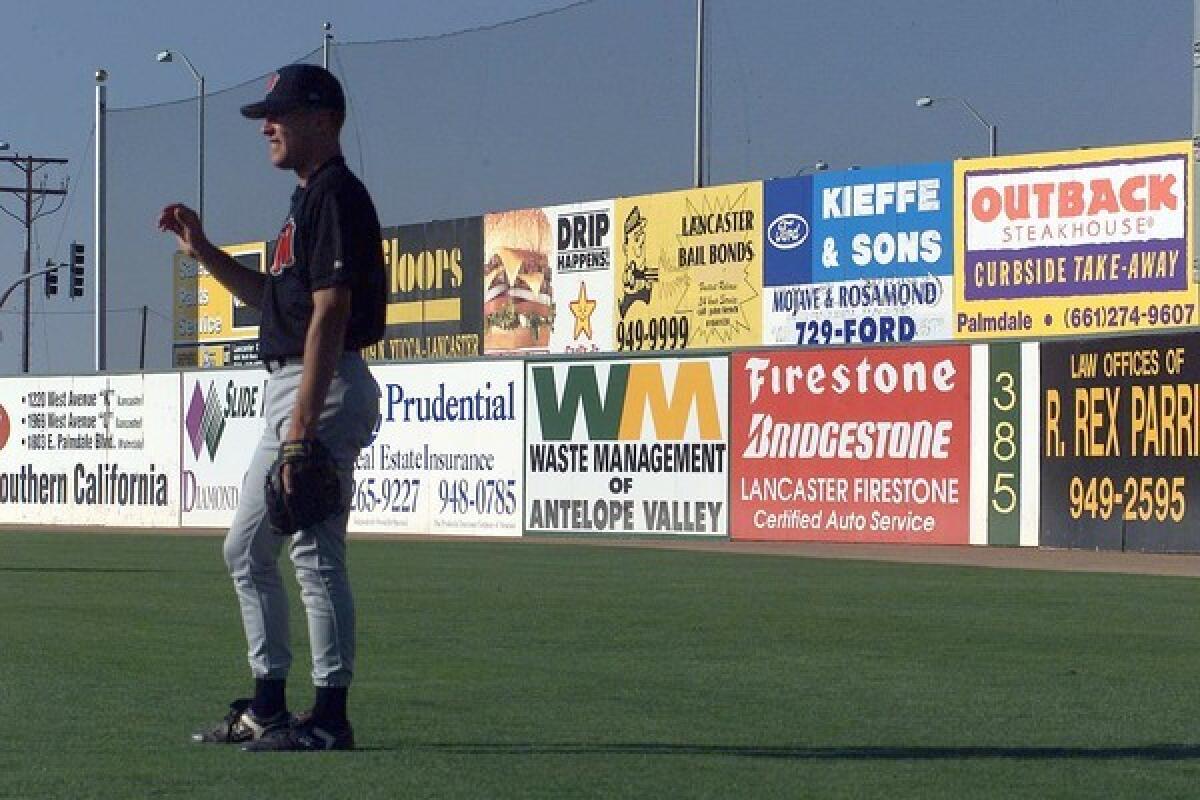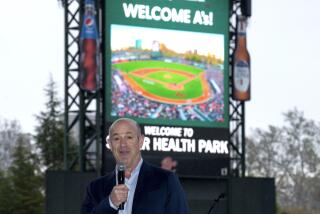Major excitement at Southern California’s minor league parks

With school out (or about to be) and long, sunny days in, the charms of baseball beckon. But if big league prices put a dent in your budget, you can still find excitement at minor league parks.
Southern California has five minor-league teams strung in a crescent on the area’s northern and eastern rims. They play in intimate parks that are far enough away to provide a getaway but close enough to constitute a day’s outing. Heading to a minor-league game is equivalent to running away to baseball never-never land, an affordable destination that can fill a summer evening to the brim.
The game at this level — the teams compete in the California League, all of them Class A affiliates of one of the major-league squads — is played by mostly twentysomethings learning their craft as they climb the ladder to the majors. Between innings, there is plenty of fun in the form of be-part-of-it contests and shenanigans.
Here’s a guide on where to go and what you’ll see when you get there:
High Desert Mavericks
Although some Southern California minor-league stadiums sport big-time trappings, the tiny Adelanto home of the Mavericks, isolated on a lonely scrub carved from the desert off U.S. Highway 395, edges closer to a junior college park on a lean budget. In fact, this may be the last season you can visit; the Mavs’ lease is up at year’s end and the franchise’s fate is further clouded by ownership issues.
But the mood is more brave than bleak. The staff’s friendly factor is high, and old-time baseball traditions are in place. (For instance, a hat gets passed to collect money for home players who hit a home run.) The experience is less about in-the-stands stunts and scoreboard pyrotechnics — there is no video board — and more about the game. Anything is possible here: In nine innings last June, the Mavs and the Lake Elsinore Storm put up a windblown 51 runs.
Inland Empire 66ers
More than the other Cal League teams, the 66ers trade on their big-league affiliation; the place bleeds Dodgers blue, with “LA” painted on the grass behind the plate (and this in a San Bernardino park), Dodgers gear in the team store, ex-Dodgers Charlie Hough and Franklin Stubbs coaching the pitchers and hitters, respectively, even Dodger Dogs.
The place has much to recommend it. It’s the only local facility with a grassy incline behind fair territory; back of left field, you can spread out a blanket and relax. The stadium was designed by the noted architectural firm Populous (then called HOK Sport), famed at building throwback parks, notably Camden Yards in Baltimore. A hacienda motif is at work here, the mustard brown facility awash with modest, pleasing-to-the-eye touches, such as quaint little carriage lamps. All told, a very enjoyable spot.
Lake Elsinore Storm
A couple of years ago, Sports Illustrated said the Storm played in perhaps the most idyllic surroundings in the minors. The magazine may have undersold it; the facility favorably compares to many of the major-league spring training complexes in Arizona.
An evening here pays off on many levels. The impeccably manicured park is framed by the Sedco Hills; sunsets create an Impressionist’s view as the fading light changes the hillside’s color palette. The team’s fierce and compelling “Eye of the Storm” logo adorns 30 cap designs and helps make Storm gear among the biggest selling in the minors. Promotions are high on creativity — Cow Appreciation Night or Pajama Jammie Jam, anyone? — and between-inning stunts are manic (recently, a Lady Ga-Gorilla dance routine made for high humor, if no sense). In short, the place exudes what minor league ambience at its peak can be.
Lancaster JetHawks
Venture up California Highway 14 to the Antelope Valley and you can expect a pleasant, albeit breezy time. The first giveaway: the flags out behind center field. They don’t flap; they fly stiff. The second noteworthy view is down the lines to the foul poles, a daunting 350 feet (usually the shortest stretch to the outfield fence) to try to keep windblown balls in the park. In the Lancaster stadium, moving your seat is not a sneaky thing to do but common sense to get to protective cover.
Beyond that, JetHawks games radiate neighborliness, an event where all the local adults seem to be on first-name basis with everyone’s kids. On a brisk May evening, the casual family feel was underscored in the middle of the sixth inning when the outfield gates parted and, to the strains of “Who Let the Dogs Out?,” a torrent of several hundred kids dashed across the outfield for the fun of it. It was an unannounced occurrence and went unremarked upon in the stands, apparently just part of what a game in Lancaster is all about.
Rancho Cucamonga Quakes
The Epicenter, the Quakes’ home, is a trim, blue-and-white stadium surrounded by neatly manicured adult softball league fields. The complex gives off a feel of baseball competency, and that, plus the proximity to the Quakes’ big-league brother, the Angels, means you have a better-than-average chance of seeing big leaguers making rehab starts here.
With Tremor and Aftershock (the earthquake theme refuses to quit), the Quakes have double the number of mascots that other teams have; the team also goes in for a percussive sound system and an on-field announcer nicknamed Johnny Baseball, who is not shy with a mike. If you like animated entertainment, the Quakes are ready to rumble.
More to Read
Sign up for The Wild
We’ll help you find the best places to hike, bike and run, as well as the perfect silent spots for meditation and yoga.
You may occasionally receive promotional content from the Los Angeles Times.






